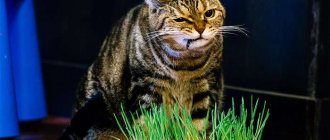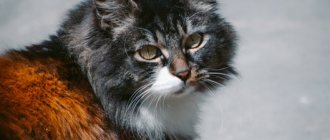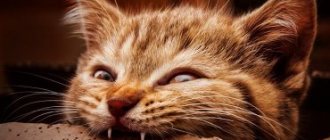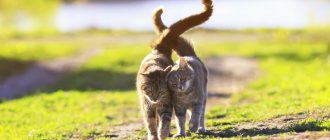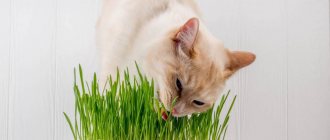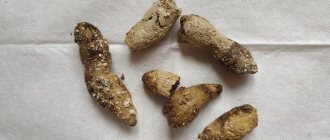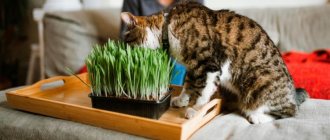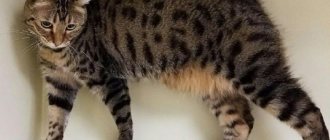"The cat eats grass." You often hear such a statement from the lips of cat owners. It turns out that this is not just another prank of your pet, but a useful activity.
Why do cats eat grass? There are many hypotheses, and so far none of them have received proper confirmation from science. However, assumptions exist, and many of them seem logical.
Why do cats eat grass?
If you notice your cat eating grass on a walk, there is no need to forbid her to do so.
There are several reasons why the mustache needs greens:
- Stomach cleansing. There are almost no coarse fibers in the animal food of the main diet, but they are present in large quantities in plant foods. As they pass through the digestive system, they clean the walls of the esophagus and intestines from food debris and pieces of hair that have stuck to the walls of the esophagus. And the most important benefit is that the herb removes toxins from the body through regurgitation.
- Improved bowel function. Some herbs have a laxative or fixative effect. Cats have preferences and some knowledge about herbs, which are determined at the genetic level. To relax the intestines, the cat will eat broad-leaved plants, and to strengthen the intestines, narrow-leaved plants.
- Diet expansion. Various greens contain many valuable macro- and microelements, vitamins and amino acids. When a cat gives birth to kittens, she chooses plants that contain folic acid. It allows you to better saturate the animal’s blood with oxygen, which has a positive effect on the development of the offspring.
- Self-medication. Scientists still adhere to this version. But when examining many cats that regularly eat greens, veterinarians did not find any significant diseases or disorders of the body.
- Taste preferences. Sometimes the pet does not swallow the plant, but only slightly bites it; from this behavior we can safely conclude that they simply like its taste.
Grass-friend and grass-enemy
Not all plants will benefit your pet - there are also some that can cause harm, including serious poisoning. Therefore, not all greens will be useful for a cat. It’s better not to keep others at home at all to avoid trouble.
Useful plants
Catnip or catnip
- Favorite herb for cats. 3% consists of essential oil, which emits an attractive smell and attracts mustaches. Although the smell is stimulating to them, eating this plant calms cats.
Schisandra
. Sedative and diuretic. Serves as an antibiotic and improves digestion.
Parsley
. Not all cats recognize parsley, but its benefits are enormous. It contains vitamin B, C, A and potassium.
Valerian
. Valerian should not be given to cats without the advice of a veterinarian, as it is addictive.
Melissa
. Acts as a laxative, therefore useful for constipation.
Marigold
. They remove worms and improve the functioning of the gastrointestinal tract. Some cats eat not only marigold grass, but also flowers. Make sure that the animal does not overdo it.
Dangerous plants
Azalea
. Contains an alkaloid that is lethal. Causes swelling of the larynx and convulsions, depresses the nervous system and disrupts the heart rhythm.
Schefflera
. Even one leaf can cause breathing to stop. If it gets into the eyes, it can cause conjunctivitis.
Cyclamen
. If your pet eats the stem of the plant, it will be poisoned. For some reason, some cats still eat this grass, as if they are somehow attracted to it. Be careful: put the flower in a pot or don’t plant it in your apartment at all.
Chrysanthemum
. Less dangerous than previous flowers, but also causes an unpleasant effect: diarrhea, vomiting and malaise.
Caladium
. Caladium juice burns the mucous membrane and leads to chronic kidney dysfunction.
What greens do cats eat?
Walking outside on a sunny day, cats do not eat all the vegetation in a row, but only plants with thin and narrow leaves.
The most delicious green cat food is wild-growing herbaceous cereals.
These include:
- Wheatgrass;
- Sedge;
- Wild oats;
- bentgrass;
- Timofeevka and others.
Behavioral reasons
Cats were once wild animals. In terms of their character, they retained their wildness, but their diet has changed a lot. For example, a cat used to eat mice and birds. The cat doesn’t particularly know how to separate fur and feathers, and she doesn’t have anything to do it with. Therefore, virtually the entire bird ended up inside, along with bones, down and feathers. Of course, only a boa constrictor can digest this, so cats have found a natural way to remove all this from the stomach. An eaten bunch of grass had an emetic and laxative effect, and everything unnecessary came out.
Cats also take care of themselves and constantly lick themselves. This is how their own fur accumulates inside, sometimes in very considerable volumes. Today, cats do not eat birds, but mostly feed on kibble. Therefore, a cat eats grass primarily to cleanse its stomach of hair.
What grass don't cats like?
Having a keen sense of smell, cats absolutely cannot tolerate vegetation that contains a lot of essential oils. Some of this vegetation is poisonous to purrs and can cause severe poisoning, for example, hyacinths or geraniums.
Field herbs that cats don't like:
- Melissa;
- Lavender;
- Sagebrush;
- Tansy.
Cats try to stay away from such plants. Owners often use such plants to wean cats from some unwanted actions. For example, when a cat scratches on furniture or shits in the corners of the room.
Cleansing the digestive tract
So why do cats eat green grass? Plants help them overcome various problems. Relief most often involves getting rid of the hairballs that pet owners all over the world know about.
Some cats may quit if there is a change in their diet, for example, but if a cat starts eating grass, know that it will do so again until the problem that caused the behavior is resolved.
Because cats lack the enzymes to digest ingested hairballs, animals that have eaten grass will then vomit that grass along with hairballs and/or other indigestible items. And if the fur has gone deep into the digestive tract, the cat will need a little help to remove it from the body naturally. In other words, if the blades of grass she eats don't come back with hairballs in the form of vomit, the cat will throw them away in her litter box.
How to grow grass for cats
Planting in vermiculite. You can buy vermiculite at any hardware or flower shop. This mineral is characterized by the fact that it retains moisture well; it also contains potassium, magnesium, ammonium and calcium, which are so necessary for any vegetation.
How to grow grass for a cat:
- The first step is to germinate the seeds. To do this, take a small part of vermiculite and fill it with warm water, then mix the mixture with the seeds, in this state the seeds should be left for 3 hours in a warm place.
- Next, you need to pour out the excess liquid and pour the mixture into any cup.
- It should be covered with cling film in order to obtain a greenhouse effect. Place in a warm place where the temperature is approximately 25-30 degrees Celsius.
- As soon as the first shoots appear, the film must be removed.
- After 5-7 days, you can treat your pet to delicious greens.
- Every 5 days you need to pour water into a cup, let it stand for 5 minutes, drain off the excess. This time is enough for the vermiculite to absorb the liquid and then gradually release it to the roots.
You cannot grow greens more than 25-30 centimeters, as then they begin to accumulate toxins that are harmful to all pets.
Safety and Prevention
If your cat has consumed grass, there are several ways it will pass through its digestive system: a hairball of grass, stool, or a combination of both. If she likes to chew grass blades periodically and removes plant material easily, you don't need to worry too much.
Now that you know the answer to the question: “Why do cats eat grass?” you can grow your own small patch of grass by planting grains of wheat and your cat will have his own private, safe lawn to graze on.
Growing in the ground
You can also grow grass for your favorite purr in a flower pot with regular soil. Before planting seeds, you should thoroughly disinfect the soil - heat it with a gas burner (laying it on the ground), this is the most accessible and effective way. But you can also moisten the soil with a weak solution of potassium permanganate (potassium permanganate).
Instructions for growing grass in the ground:
- Soak the seeds in warm boiled water in a plastic container for 10 hours for germination.
- Lay 3-4 centimeters of disinfected soil without debris, place the seeds on top with the roots down.
- They should be covered with a 0.5 cm layer of soil on top.
- After germination, you will need to water the grass every 3 days.
If the seeds have been lying around for a long time, then it is better to germinate them under cling film, where a greenhouse effect is created, then the results will be much better.
How to grow
To begin with, you should buy cereal seeds, they are sold at the pet store. Then choose a container in which you will plant the grain, it could be a container, a pot or even an old hat.
Then you need to think about where to plant. Often animals like to rummage in the ground, in addition to eating grass. Therefore, you can use cotton wool, a napkin or gauze for planting.
For seeds to germinate, not only water or sun is needed, but also the greenhouse effect, so you can cover the container with a lid or cover it with cling film.
If the cat doesn't eat grass
It may happen that all the owner’s efforts to grow greens for his furry pet will be in vain. In this case, the cat should be accustomed to greens without haste, sometimes adding them to food.
If the cat is interested in this, then in the future he will begin to eat the vegetation. If this method does not work, try sometimes offering grass to your cat, and maybe one day he will appreciate such care.
- If your pet doesn’t want to eat grass at all, you don’t need to force him.
- But if the cat, on the contrary, is very interested in devouring various types of vegetation, then there is a good reason to take him to an appointment with a veterinarian.
- Perhaps the animal has health problems that need attention.
We are sure that this article was useful for you, do not be lazy to grow a green treat for your pet yourself. She will definitely appreciate it!
Anxiety
Like humans, cats are susceptible to what is called “stress eating” or “emotional eating,” which causes the animal to eat not to relieve crippling hunger, but to relieve anxiety or satisfy an oral fixation.
If a cat is stressed, it has a need to get rid of the emotional tension that has arisen. A pet who constantly eats grass or plants may be under constant stress.
Some tips
- If your cat eats all the potted plants, buy her some normal grass at the pet store.
- Don't punish your cat for burping, he didn't do it on purpose.
- Don't force feed grass. If he doesn't want to, he doesn't eat.
- If your cat eats too much grass, make an appointment with your veterinarian. There may be problems with digestion.
- Feed freshly sprouted grass, it contains more vitamins.
Share
← How to properly trim a dog’s nails A trip to the veterinarian: how to prepare →
Poisonous plants for cats
Usually the cat can figure out on its own what kind of grass it should chew. But there are exceptions, and quite dangerous ones. For example, you should not let your cat onto a lawn that may have been sprayed with chemicals. The cat may not even notice them. In addition, there are also indoor plants that are poisonous to cats:
- Geranium
- Lily of the valley
- Tree of Life
- Cicuta
- Yew
- Squill
- Calendula
- Daffodils
- Poppy
- Henbane
- Violets
- Philodendron
- Hellebore
- Oleander
- Tulip
- Bulbous plants
In fact, the list of plants that are poisonous to cats is much longer. Here are only those of them that often end up in the house.
Are herbs always beneficial?
Cats living in nature or on the street usually instinctively choose the right herbs for medicinal or cleansing purposes. Pets do not have this experience, and their instincts are most often somewhat muted. There is a high risk for them to chew grass that is hazardous to their health while walking.
Even a plant that is safe in its composition can cause considerable harm if it grows in a polluted area - on roadsides or near industrial enterprises. In addition, there is no guarantee that this grass is not contaminated with helminth eggs or contaminated by the feces of a sick animal.
Not all outdoor grass is good for your pet.
If the animal does not leave the house and does not receive the necessary greenery in the required quantities, then it may well switch to nibbling indoor plants, some of which may be very poisonous. As a result - various troubles, even death, and specifically the following side effects:
- uncontrollable vomiting;
- digestive disorders;
- pain and cramps;
- renal, heart or pulmonary failure.
Common houseplants can cause serious harm to a cat.
Here are some houseplants to keep out of your cat's reach:
- amaralis;
- asparagus;
- geranium;
- dieffenbachia;
- caladium;
- lily of the valley;
- spurge;
- narcissus;
- oleander;
- ivy;
- spathiphyllum;
- physalis;
- ficus;
- philodendron;
- Cyperus;
- cyclamen.
Offer your pet only safe green treats.
How to make a “bed” in an apartment
Most often, grass seeds are purchased at pet stores and planted in a ready-made substrate, self-prepared soil mixture, or vermiculite.
Sequencing:
- soak the seeds for about three hours;
- pour soil into a pot or container for decorative indoor plants (2/3 of the volume);
- lay out the seed, cover with soil (2-3 cm);
- pour, cover with film.
The film is removed after seed germination. The sprouts are suitable for food after 2 weeks. To avoid a break, sowing is carried out every 3 weeks.
Some cat owners prefer to grow grass in plastic dishes. The bottom of a container with a smaller diameter is pierced in several places, cotton wool is laid out, moistened with water, seeds are poured in, and covered with gauze with large cells. A small plate is placed in a large one and covered with film.
Supplementing a cat's diet with grass is not necessary, but it is correct. It is useful if you use the one intended for pets. This is an additional source of minerals and vitamins that helps stabilize the functioning of the stomach and intestines. The home version is even better than the street version, since there is no risk of eating grass with parasites.
